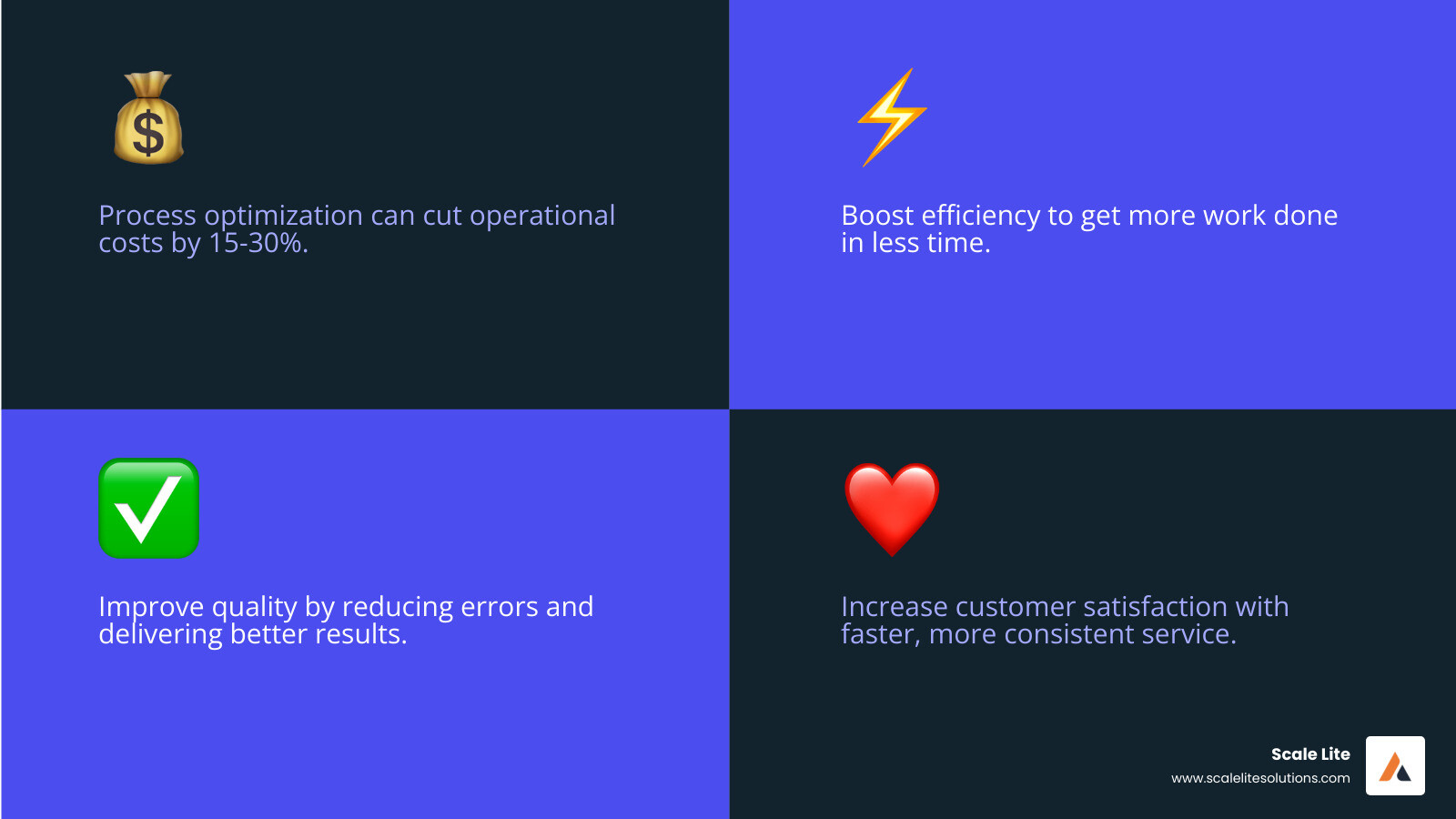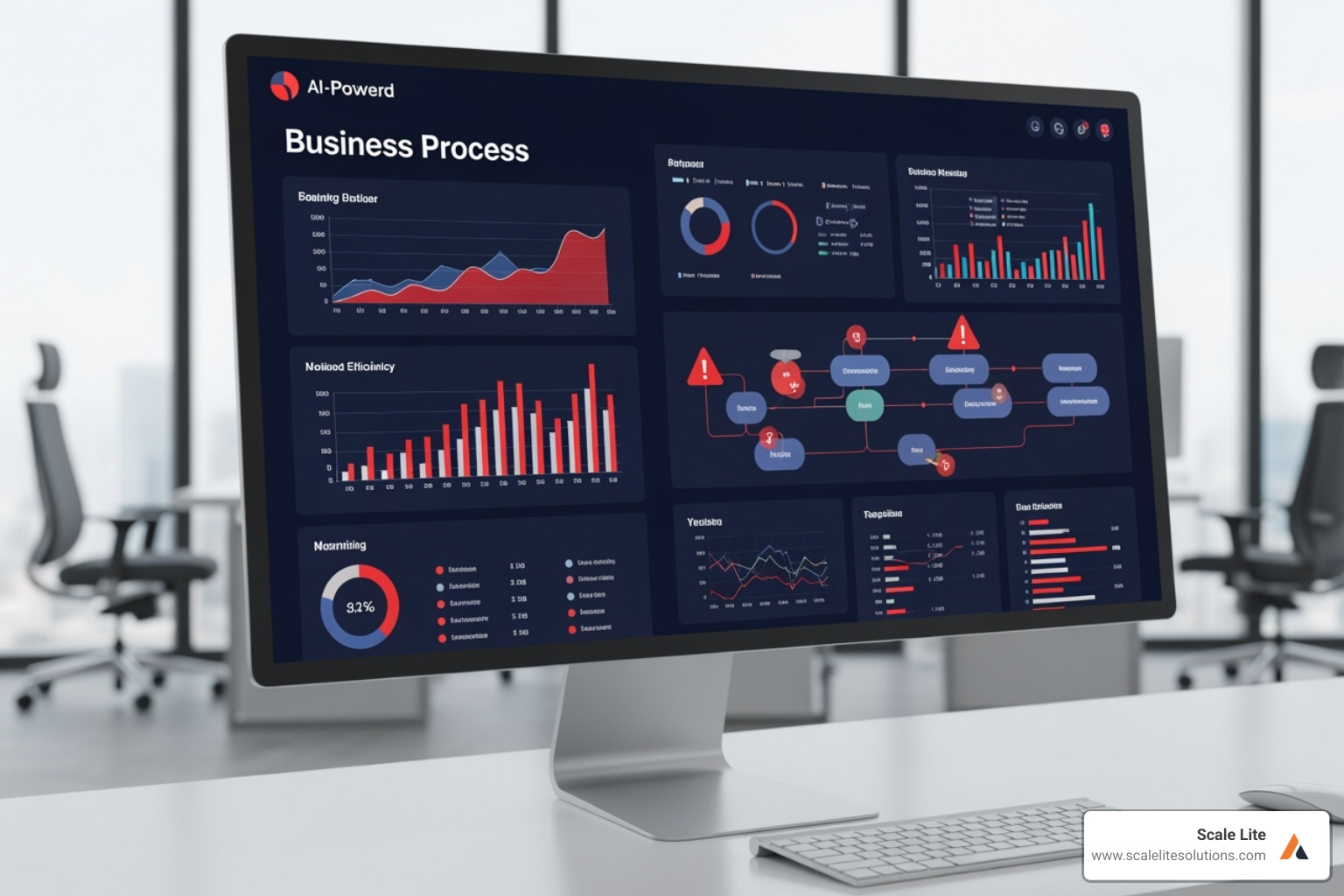
Process Perfection: How to Optimize Your Business Operations

Why Optimize Your Business Processes?
To optimize business processes means making your company's daily tasks and workflows better. It's about finding smarter, faster ways to get things done. When you do this well, you can expect to:
- Reduce Costs: Cut down on wasted time, materials, and effort.
- Boost Efficiency: Get more work done in less time.
- Improve Quality: Make fewer mistakes and deliver better results.
- Increase Customer Happiness: Provide faster, more consistent service.
- Grow Your Business Value: Build a company that runs smoother and is worth more.
Every business, from small local services to large operations, faces challenges like slow approvals, repetitive manual work, or customer complaints. These are signs that your processes need a refresh. Ignoring them can lead to wasted money and lost opportunities. Optimizing them turns chaos into clear, efficient pathways for success.
I'm Keaton Kay, founder of Scale Lite, where we specialize in helping service-based businesses optimize business processes to modernize systems and reduce owner-dependence. My background in private equity and enterprise technology has given me a unique perspective on creating scalable and sellable companies. This guide will walk you through how to achieve that perfection in your own operations.

The Compelling Benefits of Business Process Optimization
Picture your business as a well-oiled machine where every part works in perfect harmony. That's the magic of business process optimization—it transforms chaotic workflows into smooth, profitable operations that practically run themselves.
The most immediate reward you'll see is cost savings. When you eliminate those time-wasting activities that don't add real value (we call this "waste"), you stop throwing money at problems that shouldn't exist. Research consistently shows that process optimization can slash operational costs by 15-30% on average. Manufacturing businesses often see reductions of 20-35%, while administrative workflows typically improve by 10-25%.
Think about what a 20% reduction in your operational costs could mean for your business. That's money you could reinvest in growth, better equipment, or simply keep as profit.
But saving money is just the beginning. Productivity gains follow naturally when you streamline tasks and remove bottlenecks. Your team isn't working harder—they're working smarter. According to BDC.ca, one construction company saw their order processing time drop by 30% after optimizing their processes. That's the same team getting significantly more done in less time.
Your customers notice the difference too. When your internal processes run smoothly, your customer experience improves dramatically. Faster service, fewer mistakes, and quicker problem resolution lead to happier customers who stick around longer and tell their friends about you. They don't care about your internal struggles—they just want things to work seamlessly.
Business agility becomes your secret weapon in today's fast-moving market. Optimized processes are naturally more flexible, letting you adapt to new challenges or opportunities without missing a beat. Whether it's adopting new technology, scaling up operations, or pivoting during tough times, you'll be ready.
There's also the often-overlooked benefit of risk mitigation. Streamlined processes come with better controls and clearer accountability. This means fewer costly mistakes, better compliance with regulations, and protection from operational headaches that could hurt your business.
All these improvements work together to boost your business valuation. A company that runs efficiently, delights customers, and adapts quickly is worth more—whether you're looking to sell, attract investors, or simply build something valuable. Our clients regularly find How to Improve Business Performance by focusing on these fundamental improvements that create lasting value.
The 7-Step Blueprint to Optimize Business Processes
Optimizing business processes isn't a one-time fix; it's a strategic journey. But don't worry, we've broken it down into a clear, actionable 7-step blueprint. Think of it as your roadmap to operational excellence.

Step 1: How to Identify and Prioritize Processes for Optimization
Before you can fix something, you need to know what's broken (or at least, what could be better!). This first step is crucial for ensuring your efforts are focused where they'll have the biggest impact. It's about being smart with your time and resources.
Start by looking for high-impact processes that directly affect your customers or your profitability. These are often customer-facing workflows, like how you onboard new clients, handle service requests, or send out invoices. Any process that touches your customer directly is a prime candidate, as improving it can lead to immediate boosts in customer satisfaction and loyalty.
Next, consider your high-volume tasks. These are the processes your team performs repeatedly throughout the day, week, or month. Even small inefficiencies in these areas can lead to significant cumulative waste over time. Think about how many times you process a payment, respond to a common customer question, or manage your inventory. A tiny delay in each instance adds up to a huge problem.
Then, hunt for obvious pain points. Where do things consistently go wrong? Where are the delays, the errors, or the frustrations that your team often talks about? Your employees, the people on the front lines, often have the best insights into where the inefficiencies lie. This is why employee feedback is a critical resource. As an expert on LinkedIn wisely points out, "Communication with people doing the work is extremely crucial when assessing the current state." Their day-to-day experience is invaluable.
To help you decide where to start, create a prioritization matrix. This simple tool allows you to rank potential processes for optimization based on a few key factors:
- Impact: How much will improving this process benefit your business (e.g., cost savings, happier customers, more revenue)?
- Feasibility: How easy or difficult will it be to make the changes?
- Urgency: Does this process need immediate attention due to big customer complaints, compliance risks, or a lot of wasted resources?
Focusing on processes that are high-impact, high-volume, and have clear pain points will give you the most bang for your buck. This strategic approach helps us Improve Business Operations effectively, making sure our efforts are always directed towards maximum value.
Step 2: Map Your Current Reality
Once you've picked a process to optimize business processes, the next step is to truly understand it. This means creating an "as-is" map. Think of it as drawing a detailed picture of how things actually work today, not how you think they work or how they should work.
Process mapping is the art of visualizing your workflow. Tools like flowcharts and swimlane diagrams are incredibly helpful here. A flowchart shows the simple sequence of steps, decisions, and outcomes. A swimlane diagram takes it a step further by showing which team or person is responsible for each step. This makes handoffs and accountability much clearer.
As BDC.ca points out, "Process mapping is about making processes visual, clearly establishing how processes really work so that everyone is on the same page." It's a fantastic way to highlight where waste or frustration might be hiding.
Crucially, this isn't a solo mission. It's time to involve the team—the very people who perform the process and those who receive its outputs. They are the true experts! Gather them in a room (or a virtual meeting) with a whiteboard, sticky notes, or a digital mapping tool. Ask them key questions like:
- What is the main goal of this process?
- When does it begin and end?
- What are the specific steps involved?
- Who does what at each point?
- What tools or systems are used?
- What documents or information are created or passed along?
This collaborative effort ensures accurate documentation of steps and helps everyone feel invested. It's often during this mapping phase that team members collectively realize just how convoluted or inefficient a process has become. For more insights on this, check out Visualizing your process landscapes.
Step 3: Analyze for Bottlenecks and Waste
With your process mapped out, it's time to put on your detective hat and start analyzing. Your goal is to uncover the root causes of inefficiencies, delays, and errors. This is where the magic (and sometimes the "aha!" moments) happens!
Effective analysis requires good data collection. You need objective information about how the process performs. This might include numbers like:
- Cycle time: How long does it take from the very start to the very end?
- Error rates: How often do mistakes happen at each step?
- Rework rates: How much time is spent fixing errors that shouldn't have happened?
- Resource utilization: Are people or equipment sitting idle, or are they constantly overloaded?
Once you have this data, you can begin root cause analysis. One popular and simple technique is "The 5 Whys." For every problem you identify, ask "Why?" five times (or until you get to the fundamental cause). For example, if customer service calls are often too long, you might ask:
- Why are calls too long? Because agents spend too much time searching for information.
- Why do they search so long? Because information is in many different systems.
- Why is information in different systems? Because our systems aren't integrated.
- Why aren't they integrated? Because we haven't prioritized that project.
- Why haven't we prioritized it? Because we didn't realize the huge impact on customer experience and agent efficiency.
This simple method helps you move beyond just the symptoms to uncover the real, underlying issues.
During this analysis, you'll be actively identifying redundancies (duplicate efforts, like two people checking the same thing), pinpointing delays (waiting times between steps), and spotting non-value-added activities. These are steps that consume resources but don't add value from the customer's perspective. Think of excess paperwork, unnecessary approvals, or redundant checks. Eliminating these is like shedding dead weight—it makes your process leaner and faster.
Step 4: Redesign for Peak Efficiency
Now for the fun part: creating the "to-be" process! This is where you get to release your creativity and problem-solving skills to build a better, faster, and more effective workflow. This step is all about Business Process Streamlining.
The core of redesign is simplifying steps. Can you remove any unnecessary tasks you identified in the analysis phase? Are there fewer ways to achieve the same outcome? Sometimes, a complex process is just a series of simple steps that got tangled over time. Your job is to untangle them!
Consider re-engineering workflows. This might involve changing the sequence of tasks, combining steps, or completely overhauling how a specific part of the process operates. Don't be afraid to challenge the status quo. Just because "we've always done it this way" doesn't mean it's the best way for your business today.
A key strategy is designing the "to-be" process with efficiency in mind. This includes:
- Eliminating loops: If a process frequently cycles back on itself for re-work or re-approval, find ways to ensure quality at earlier stages.
- Reducing handoffs: Each time a task is passed from one person or department to another, there's a potential for delay or miscommunication. Minimize these handoffs where possible.
- Parallelizing tasks: Can some activities happen at the same time instead of one after another? For instance, while one team prepares a quote, another might be gathering client background information.
The goal is a process that is clear, direct, and focused on delivering value with minimal friction. This is how you truly optimize business processes.
Step 5: Implement and Manage the Change
You've designed a brilliant new process. Now, how do you make it a reality without causing chaos? This step is about careful execution and thoughtful change management.
Start with pilot testing. Don't roll out a new process across your entire organization overnight. Test it with a small team or in one department first. This allows you to identify any unforeseen issues, gather feedback, and make adjustments in a controlled environment. Think of it as a dress rehearsal before opening night.
Clear communication is paramount. Explain why the changes are happening, what the new process entails, and how it will benefit everyone involved (and the customer!). People are naturally resistant to change, especially if they don't understand its purpose. Address concerns openly and honestly. As the LinkedIn article on unoptimized processes suggests, involving employees and communicating with them is "extremely crucial."
Provide thorough team training. Don't just hand out a new manual and expect everyone to be an expert. Offer hands-on training, Q&A sessions, and ongoing support. Make sure everyone feels confident and capable in the new workflow.
Anticipate and address resistance to change. Some employees might be comfortable with the old ways, or they might fear that the new process will make their jobs harder. Listen to their concerns, involve them in finding solutions, and highlight the positive impacts on their daily work. Building a sense of shared ownership helps secure buy-in. When people feel they're part of the solution, they're much more likely to accept and accept it.
Step 6: How to Measure the Success of Your Process Optimization Efforts
How do you know if all your hard work is paying off? By measuring, measuring, measuring! This step is about proving the value of your optimization efforts and ensuring that the improvements stick.
Start by defining clear Key Performance Indicators (KPIs). These are the metrics that tell you whether your new process is performing as intended. For example, if you optimized an invoicing process, your KPIs might include:
- Cycle time: The average time from when you create an invoice to when you receive payment.
- Error rates: The percentage of invoices that have mistakes.
- Cost per transaction: The average cost to process just one invoice.
Investopedia defines key performance indicators as crucial for continuous monitoring and analysis. Without them, you're making changes based on assumptions rather than factual insights.
Next, calculate the ROI (Return on Investment) of your optimization. This involves comparing the costs of implementing the changes (like time spent, new technology, or training) against the benefits (cost savings, increased revenue, improved efficiency). A well-executed process optimization project typically achieves ROI within 6-18 months, with typical ROI ranging from 150-400% within 12-24 months. These are numbers that make stakeholders smile!
Performance dashboards are excellent tools for visualizing your KPIs in real-time. This allows you to quickly see how the process is performing, identify any new issues, and celebrate successes. Seeing tangible improvements motivates the team and reinforces the value of working to optimize business processes.
Focus on specific metrics like the average cycle time for a task, the error rates at different stages, and the cost per transaction. These quantifiable measures provide objective evidence of your positive impact.
Step 7: Foster a Culture of Continuous Improvement
Congratulations, you've optimized a process! But the journey doesn't end there. Business process optimization isn't a destination; it's a continuous journey. The market changes, technology evolves, and your business grows. What's efficient today might be outdated tomorrow.
This step is about embedding the philosophy of improvement into your company's DNA. Accept the Kaizen philosophy, a Japanese term meaning "change for the better" or "continuous improvement." It emphasizes making small, incremental changes regularly, involving everyone from top management to frontline employees.
Establish regular feedback loops. Encourage employees to report new inefficiencies, suggest improvements, and share their insights. Make it easy for them to do so and show that their input is valued and acted upon. This could be through regular meetings, suggestion boxes, or dedicated digital channels.
Conduct regular reviews of your optimized processes. Set a schedule—quarterly, bi-annually—to revisit your process maps, check your KPIs, and discuss any emerging issues. Are the improvements holding? Are there new opportunities for refinement?
Finally, empowering employees is key. Give them the autonomy and tools to identify and solve problems within their own workflows. When everyone feels responsible for improving the business, you create a powerful engine for ongoing optimization. This culture of constant refinement is a hallmark of Operational Excellence Strategies.
The Modern Toolkit: Leveraging Technology for Optimization
You don't have to optimize with just pen and paper. Technology is your superpower, changing how we approach business process optimization. It's like upgrading from a manual screwdriver to a power drill – the job gets done faster, more accurately, and with less effort.

The Role of Automation and AI
At the heart of modern BPO is workflow automation. This means using software to handle repetitive, rule-based tasks that humans used to do. Think about data entry, sending standard emails, or moving files between systems. Automating these tasks frees up your team for more complex, value-added work. Kissflow, for example, helps organizations streamline and automate workflows to improve efficiency and reduce costs.
Robotic Process Automation (RPA) is a specific type of automation where software "robots" mimic human actions to interact with digital systems and applications. It's fantastic for automating tasks without needing to overhaul your entire IT infrastructure.
However, a crucial piece of advice: always focus on optimizing before automating. As the saying goes, "Automating a mess creates an automated mess." First, streamline your process, remove waste, and then apply automation to the refined workflow. This ensures you're amplifying efficiency, not inefficiency.
Beyond simple automation, Artificial Intelligence (AI) is revolutionizing BPO. AI can analyze vast amounts of process data to identify patterns and inefficiencies that humans might miss. It can provide AI for predictive analysis, foreseeing bottlenecks before they even occur. Generative AI, for example, can improve decision-making and eliminate the need for time-consuming human intervention in many initiatives, according to Capgemini. This capability helps organizations improve processes better than when done manually. IBM also highlights how business process automation tools, AI-driven analytics, and cloud-based systems can optimize workflows and reduce human errors. Our AI-Driven Workflow Automation solutions are built on these principles.
Essential Systems for Service Businesses
For blue-collar service businesses and low-tech industries, specific technological systems are particularly impactful for optimization:
- CRM Systems: A Customer Relationship Management (CRM) system centralizes all your customer data and interactions. This means everyone on your team has access to the same up-to-date information, leading to better customer service, more efficient sales processes, and improved client engagement. No more hunting through spreadsheets or sticky notes for client details!
- Data Analytics Platforms: These tools collect and analyze data from your operations, giving you insights into performance, trends, and areas for improvement. They can track everything from job completion times to customer feedback, providing the objective data needed for informed decision-making.
- Digital Tools for Field Operations: Mobile apps for job scheduling, dispatch, invoicing, and even digital business cards can transform how your field teams operate. They reduce paperwork, improve accuracy, and provide real-time updates, making your entire operation more responsive.
The goal is to move towards a system of centralized data, where information flows seamlessly between different parts of your business. This eliminates data silos, reduces manual data entry (and associated errors!), and gives you a holistic view of your operations. These systems are foundational for Scalable Service Operations.
Common Pitfalls and How to Sidestep Them
Let's be honest—optimizing business processes doesn't always go smoothly. Even with the best plans and intentions, things can go sideways. But here's the good news: most of these stumbling blocks are predictable, and once you know what to watch for, you can steer around them like a pro.
The biggest challenge you'll face is resistance to change. It's human nature! Your team has been doing things a certain way for months or years, and suddenly you're asking them to learn something new. Some folks might worry about job security, others simply prefer the familiar. This resistance can kill even the best optimization efforts before they get off the ground.
The key to sidestepping this challenge is involvement and communication. Bring your team into the process from day one. When people help design the solution, they're much more likely to accept it. Explain the "why" behind every change—how it will make their jobs easier, reduce frustration, or help the company grow. Provide thorough training and ongoing support. And don't forget to celebrate those small wins along the way! When people see real benefits, resistance melts away.
Another common trap is lack of leadership buy-in. If your management team isn't fully committed, the initiative will struggle. Without proper resources, executive support, and visible leadership participation, optimization efforts often fizzle out when the going gets tough. Leaders need to champion these efforts actively, not just give them lip service.
Poor data quality can derail your entire optimization journey. If your information is inaccurate, incomplete, or outdated, your analysis will lead you down the wrong path. As HeFlo points out, ignoring data quality is a common pitfall that leads to flawed improvements. Remember: garbage in, garbage out! Invest time in establishing clear data entry standards and validation processes before you start making big changes.
Here's a mistake that makes us cringe every time: automating a bad process. We see this all the time—businesses get excited about new technology and jump straight to automation without first streamlining their workflows. All this does is make inefficiencies happen faster and more consistently. Always optimize first, then automate. Get the process right, remove the waste, and then introduce technology to amplify your improvements.
Don't forget about your customers while you're focused on internal efficiency. Overlooking customer experience is a trap that can backfire spectacularly. Sometimes, what seems efficient internally can create friction for your customers. As Artsyltech emphasizes, focusing on customer experience is crucial for success. Keep asking yourself: "How will this change affect our customers?" Gather their feedback regularly and adjust accordingly.
Finally, watch out for departmental silos. When teams work in isolation, processes often break down at the handoff points—exactly where customers feel the impact most. Kissflow notes that breaking down these silos is key to improving business process efficiency. Foster cross-functional collaboration during your optimization efforts. Encourage different departments to work together on process mapping and redesign. Those invisible walls between teams can be the biggest barriers to smooth operations.
By staying alert to these common pitfalls, you can proactively plan around them, ensuring your efforts to Streamline Operational Processes deliver the results you're hoping for.
Frequently Asked Questions about Business Process Optimization
We love getting questions about business process optimization! It shows that business owners are really thinking about how to make their operations better. Let me tackle some of the questions we hear most often.
What's the difference between process optimization and process improvement?
While these terms are often used interchangeably, there's actually an important difference that can help you decide which approach to take.
Process improvement is like fixing a leaky faucet. You notice a specific problem—maybe invoices are getting stuck in approval, or customer calls aren't being returned quickly enough—and you make targeted changes to address that issue. It's typically reactive, responding to problems as they pop up, and focuses on making incremental changes that improve things step by step.
Process optimization, on the other hand, is more like renovating your entire kitchen. You step back and look at the whole workflow from start to finish, asking whether this is really the best way to achieve your goals. As workflow experts at Kissflow explain, "While both aim to improve workflow performance, process improvement is typically a reactive approach... In contrast, process optimization is a more strategic and proactive discipline."
When you optimize business processes, you're often redesigning entire workflows, potentially bringing in new technology, and making strategic changes that align with your bigger business objectives. It's proactive rather than reactive, and it usually delivers more dramatic results.
Think of it this way: improvement makes things better, but optimization makes things the best they can be.
Which processes should a small service business optimize first?
This is probably the most practical question we get, and I totally understand why. When you're running a small service business, you can't optimize everything at once—you need to be smart about where you focus your energy.
Start with processes that directly touch your customers. Your customer onboarding process sets the tone for the entire relationship. If new clients have to jump through hoops or wait too long to get started, that's your first priority. Similarly, your quoting process can make or break sales opportunities. Customers expect quick, professional quotes, and a clunky process here costs you money.
Invoicing is another goldmine for small businesses. Many service companies are still printing invoices, stuffing envelopes, and waiting weeks for payment. Streamlining this process can dramatically improve your cash flow—and cash flow is the lifeblood of small businesses.
Don't overlook job scheduling either. If your team is constantly confused about where they need to be and when, or if you're double-booking appointments, fixing this process will reduce stress and improve customer satisfaction immediately.
The key is focusing on what we call "high-impact, low-effort" processes. These give you the biggest bang for your buck and help build momentum for tackling more complex optimizations later.
How long does it take to see ROI from process optimization?
This is the million-dollar question, isn't it? The good news is that you don't have to wait years to see results from your optimization efforts.
Most well-executed process optimization projects show a solid return on investment within 6-18 months, according to business process experts at BOC Group. But here's what's really encouraging—you'll often see benefits much sooner than that.
Quick wins can happen within weeks. Maybe you eliminate a redundant approval step and suddenly invoices get processed twice as fast. Or you implement a simple digital tool that stops your field team from driving back to the office just to file paperwork. These immediate improvements boost team morale and prove that the changes are working.
The long-term gains are where the real magic happens. As your new processes become second nature and their effects ripple through your entire operation, you'll see the full financial impact. Successful projects typically deliver ROI ranging from 150-400% within 12-24 months. That's not just getting your money back—that's multiplying your investment.
The timeline really depends on your project scope and implementation quality. Simple changes like digitizing forms show results faster than completely overhauling your entire customer management system. But even complex projects start paying dividends relatively quickly when they're done right.
The beauty of process optimization is that once you get those systems humming, they keep delivering value year after year. It's an investment that keeps paying you back.
Conclusion: Building a More Valuable and Scalable Business
So, we've journeyed through the ins and outs of business process optimization. It’s clear that optimize business processes isn't just a fancy phrase; it's a vital strategy for any business eager to thrive and grow in today's world. Think of it as tuning up your business engine – making it not just efficient and profitable, but also super resilient and ready for anything.
We've seen how Business Process Optimization (BPO) can work wonders. It can significantly slash your costs, give a massive boost to your team's productivity, genuinely delight your customers, and ultimately, increase the overall value of your business. That's a pretty powerful combination, right?
We also walked through our clear, 7-step blueprint. From figuring out which processes to tackle first and mapping how they actually work, to redesigning them for peak performance, putting those changes into action, and then carefully measuring the results. Plus, we highlighted how incredible modern technology, especially smart automation and AI, can be your ultimate sidekick in this whole adventure.
But here's the honest truth: optimizing your business is a continuous journey, not a finish line you cross once. It asks for your dedication, calls for genuine team involvement from everyone, and requires a willingness to accept change. Yes, it takes effort. But the payoff? A business that's leaner, faster, laser-focused on your customers, and ultimately far more valuable. That's a reward well worth striving for.
At Scale Lite Solutions, we live and breathe this stuff. We specialize in helping blue-collar service businesses and those in low-tech industries achieve this very level of operational brilliance. Our mission? To help you build Businesses That Run Themselves, giving you, the owner, the freedom to dream bigger, innovate more, and focus on growth instead of getting tangled in the day-to-day grind.
Ready to open up your business's full potential and truly transform your operations? We're here to help you take that exciting next step. Learn how AI and automation can transform your operations and kickstart your journey towards process perfection today!






